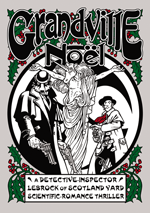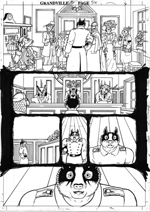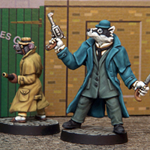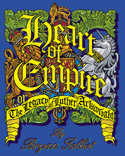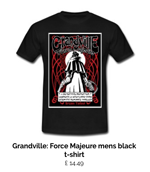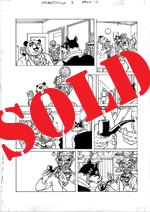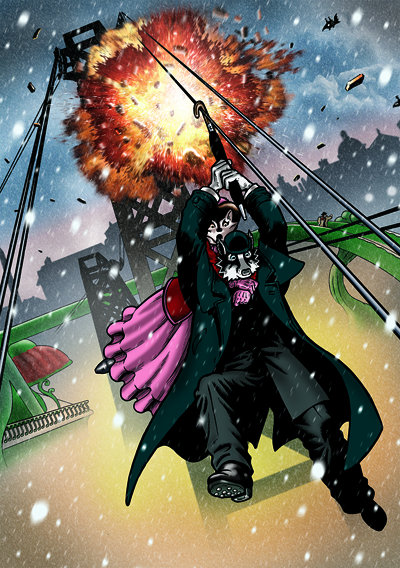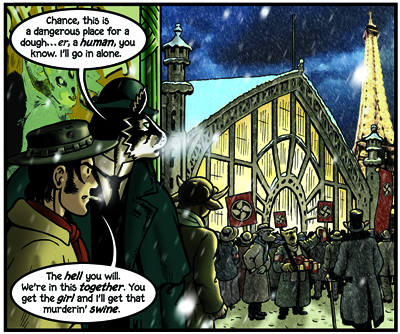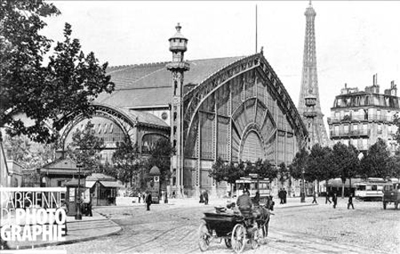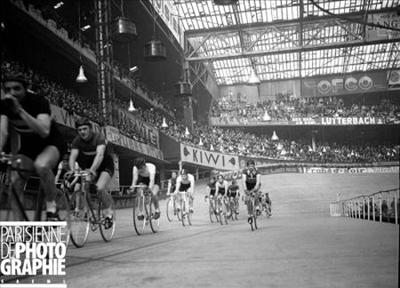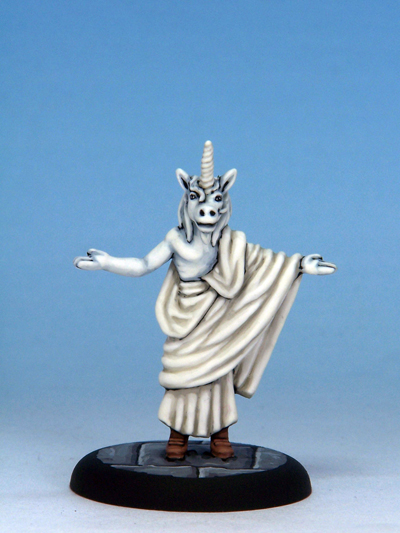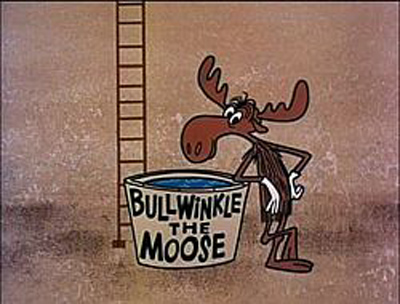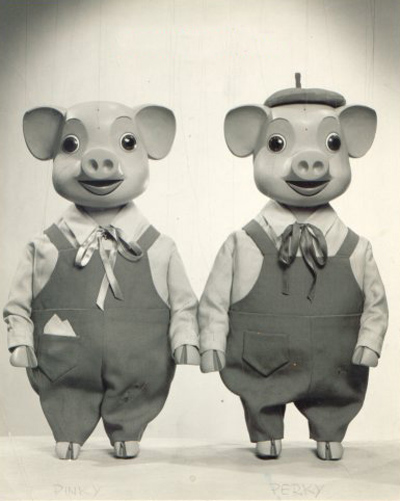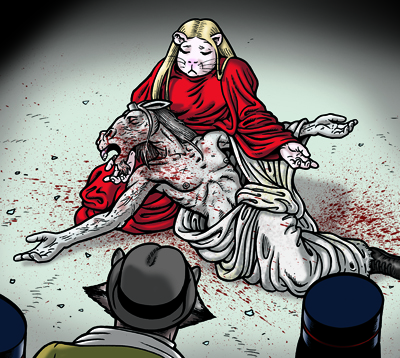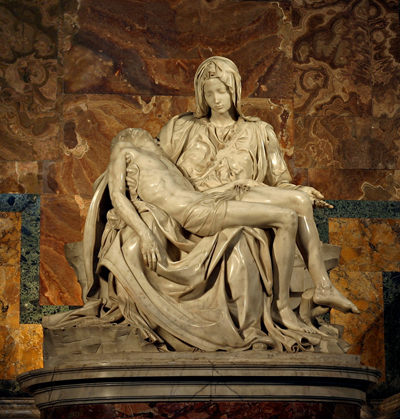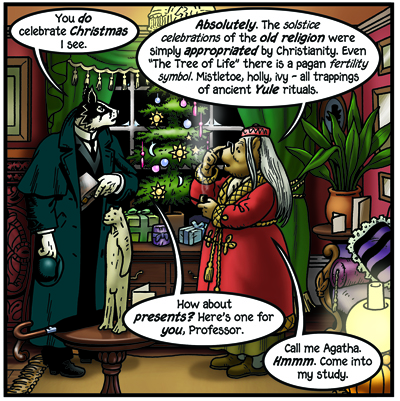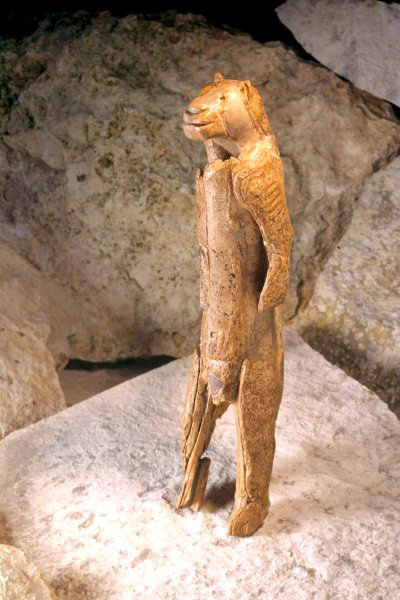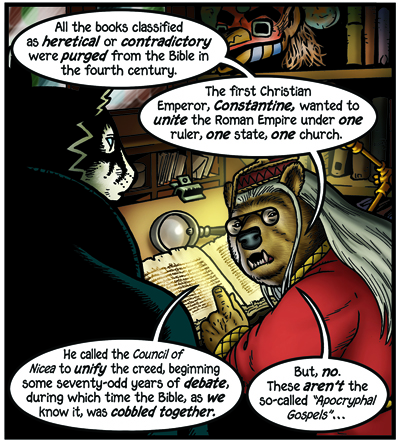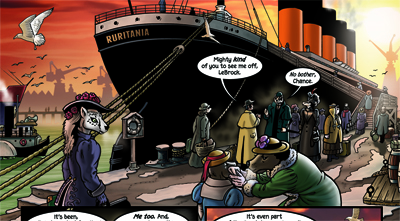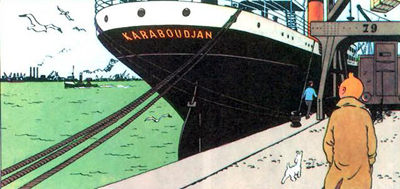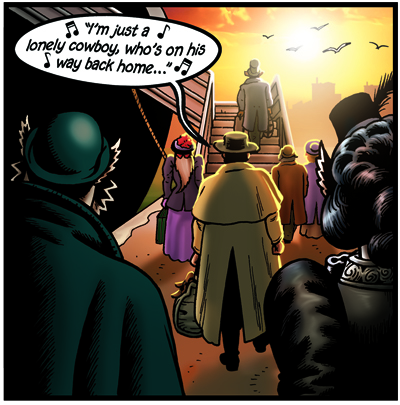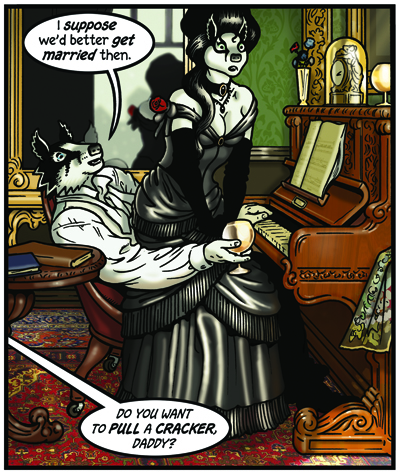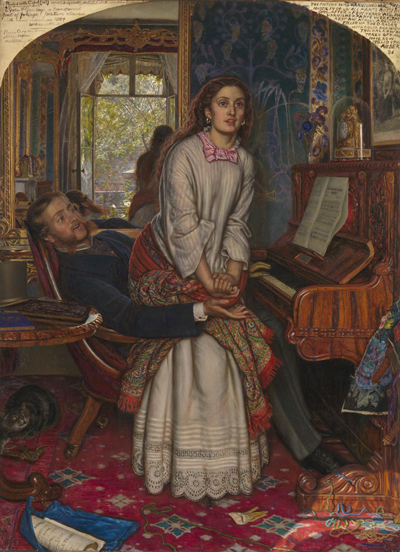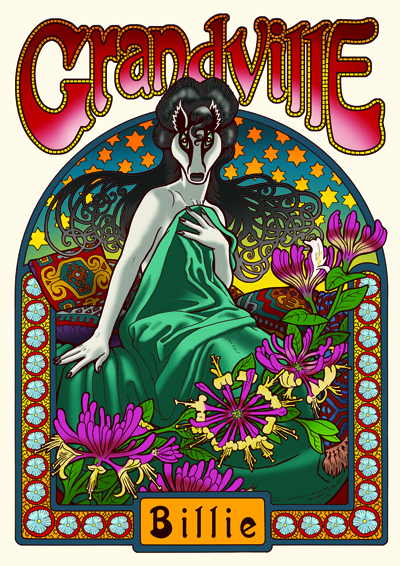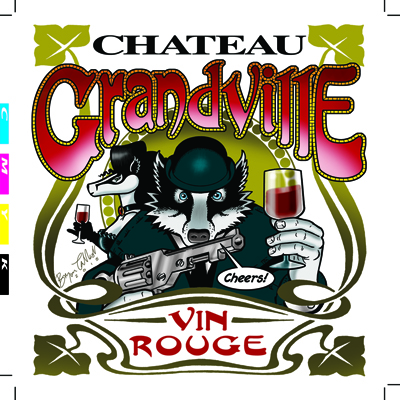Grandville Noël annotations - batch 4
This is similar in concept to the Directors Cut of Heart of Empire that Bryan and myself created: it is an attempt to answer the eternal "where do you get your ideas from?" question, and a way to showcase the influences and images that went into the creation of Grandville.
We are publishing updates to this page every Sunday and we will cover the entire Grandville series: we have already completed the annotations for Grandville, Grandville Mon Amour and Grandville Bête Noire.
Start reading the Grandville Noel annotations below, or jump straight to page 66, page 67, page 70, page 73, page 74, page 75, page 77, page 78, page 79, page 80, page 82, page 83, page 84, page 86, page 87, page 88, page 89, page 90, page 91, page 94, and page 95,
Page 66
Panel 1
Unsurprisingly, the yobs who go on about immigrants destroying British culture wouldn’t even be able to name one of Chaucer’s Canterbury Tales or a symphony by Elgar, give you a quote from Oscar Wilde or tell you who David Lean, Graham Green, Malvolio, Turner, Coleridge or Daphne du Maurier are.
Panel 6
Extremism always creates extremist opposition.
Without intending it, I somehow made the leader of this band of doughface terrorists a little like Captain Mainwaring from Dad’s Army.
Page 67
Panel 8
Cherie Rocher, introduced in Grandville Bête Noire, returns.
Page 70
Panels 7, 8 & 9
Inspired by a Lee Van Cleef scene in For A Few Dollars More.
Page 73
One of my favourite pages.
Page 74
Panel 5
The Winter Velodrome: the Vélodrome d’Hiver was an indoor bicycle racing track, not far from the Eiffel Tower, originally built for the World’s Fair that ended in 1900.
It was used in the 1930s for rallies by the French fascist, anti-semitic party, the PPF, the Parti Populaire Français, (“French Popular Party”). Apollo’s political party is called the Popular Unity Party.
During the occupation of Paris it was used to house 12,884 Jewish prisoners before they were shipped to concentration camps, ultimately Auschwitz. These included thousands of children and infirm and elderly people. They were kept there for a week with no food and only 4 toilets. Under orders from the German authorities, this act of barbarity was committed by ordinary French policemen to ordinary French citizens. We should never forget how dangerous and inhuman right wing ideology is. It turns ordinary people into monsters.
Page 75
Panel 2
In the foreground is a Mickey Mouse carnival parade head.
Panel 3
Crooked Dice also did a figurine of Apollo.
Page 77
Panel 3
You can just about see a Bullwinkle head in the background.
Page 78
Panel 3
Pinky and Perky were a pair of puppet pigs who had their own children’s TV show in the late 50s and early 60s. Singing in speeded-up voices (a bit like the Chipmunks), they sang cover versions of songs, mainly from the top 20. I believe they were revived around 2010 in a CGI version.
Page 79
Panel 3
What he says about the suastika (an old spelling) is basically true.
Page 80
Apollo, besides from the fact that, without his horn which gave him his animal magnetism, we now see him as he really is, we’re no longer perceiving him as talking in iams (see page 3 notes).
Page 82
Panel 4
“Waste not, want not…as my grandma used to say as she polished off the scotch.” This is taken straight from my maternal grandmother, who I talk about in the afterword to Force Majeure.
Panel 6
Based on the idea of the Pietà (Italian, literally “Compassion” or “pity”). Pietàs are mainly sculptures depicting the Virgin Mary cradling the dead body of Christ. Here’s the famous one by Leonardo da Vinci 1452 – 2 May 1519) which is housed in the Vatican.
As I mentioned in the annotations for page 43, virgins are closely associated with the fate of unicorns.
Page 83
I really wanted to keep this page on a left-hand side. It’s always important in comics to design facing pages at the same time and, if possible, have scenes ending on a right hand page. An entire atmosphere can be encapsulated between 2 pages, enabling the illustrator to change atmospheres by turning the page. Have I said this before in these annotations? Probably. It’s important to keep surprises hidden over the page. In this case I just couldn’t do it and keep to the 96-page format without drastic condensing or breaking the 2-page layouts of the remaining scenes.
Page 84
Panel 4
I came across this hypnotism formula in Tricks of the Mind, a book by Darren Brown, who started off a stage hypnotist.
Page 86
Panel 4
This is really based on a French convent, but I can’t remember exactly where.
Page 87
Panel 3
“Your eminence” is how you’re supposed to address a cardinal.
Page 88
Panel 3
What professor Ursine says about Christmas is correct. Her tree is decorated with pagan suns and moons.
On the table in the foreground she has (presumably a copy) of the Löwenmensch, found in the Stadel Cave in Southern Germany. At 40,000 years old, it’s the oldest example of figurative art in the world and, yes, it’s anthropomorphic. People have told stories of anthromorphic characters as long as people have told stories, and there are many other prehistoric examples, including many cave paintings. It’s carved from a woolly mammoth tusk and stands 31 cm high. It’s disputed whether the lion-headed figure is male or female.
Panel 5
Everything the professor says is true in our world too. The text you can see in the book is Aramaic.
Page 89
Panel 1
The carved wood head in the background is drawn from one I brought back from Brazil, many years ago. It’s a tourist version of the sort of design found on the carved bows of the canoes used by Amazonian native tribes.
Panel 2
The text here is indeed Hebrew.
Page 90
Panel 1
This panel pays homage to another classic Hergé pane, this time from Le crabe aux pinces d’or (“The Crab with the Golden Claws”).
The head of the strange female animal to the left is drawn from the mask of a Swedish furry cos-player who’s a big Grandville fan.
Ruritania: the name of a fictional Central European country in some books by Anthony Hope (1865 – 1933) including The Prisoner of Zenda.
Panel 5
In the final panel of every Luke Luke story (with the exception of the very earliest), he rides off into the sunset singing “I’m a poor lonesome cowboy, and a long way from home”.
Page 91
Panel 3
Mister Crock: a silly joke. A popular French snack is toasted cheese and ham sandwich, known as a croque-monsieur. ‘Croque” means to crunch or munch.
Page 94
Panel 1
We finally meet Papa Ratzi, ( a joke! Paparazzi!) as mentioned in the very first Grandville. It was James Robertson, my (by now) old friend and website wallah, who suggested that, to continue the joke, I make him a keen photographer. This turned out very well as, in Force Majeure, I make use of his photography skills and his Italian name.
Roderick: “Go and get the others!” This joke is blatantly lifted from the hilarious “Every Sperm is Sacred” sequence in Monty Python’s The Meaning of Life.
Panel 4
Jack and Arabella. We’re never told this, but LeBrock named Jack and his wife Florence named Arabella. Florence was middle-class, LeBrock definitely working-class.
Page 95
Panel 7
Based on The Awakening Conscience by William Holman Hunt (1827 – 1910), a painting depicting a man and his mistress. There’s a good description of its coded meanings on its Wikipedia page.
“Pull a cracker”: for the benefit of non-British readers, this is a double-entrendre. Jack’s obviously referring to a Christmas cracker here but “pull” is UK slang for successfully sexually attracting a woman, a “cracker”: a good-looking woman.
In 2014, the year that Noël was published, the Lakes International Comic Art Festival (LICAF) had its own wine. This is the label I did for the red, "Chateau Grandville". A year or so earlier, I'd done the Mucha-style illustration of Billie above for the festival, as one of several done by various artists and sold as prints to help raise funds. It seemed a good idea to include it in the book as an extra.
Seeing as Mary and I are two of the founder patrons of the festival, it seems fitting to end these Grandville Noël annotations with some information about LICAF.
The Lakes International Comic Art Festival started in 2013. Although there have been comic conventions and marts in the UK since the 60s, this is the first and only European-style comics festival in Britain. Held in the picturesque market Town of Kendal, it really becomes a town "en fête", involving not only comics fans from around the country and the world, but also the local community. Kendal, like Lucca, is a small enough town to take over for the weekend.
The main venue for talks is the Arts Centre, with the dealer's room , artists' alley and other events filling the town hall and several other buildings, including the library, art galleries and the shopping mall, which is the family zone, featuring children’s comic publishers and artists. All these events are only a few minutes’ walk from each other.
There's a comic-themed film festival, banners in the streets, exhibitions and even comic displays in many of the high street store windows. The “Friday Sessions” is a day of academic talks on the comic medium.
The festival runs comic programmes in the local schools leading up to the festival, and Kendal College is heavily involved. There is even a special festival beer and wine.
The festival aims to cover the whole world of comics, from "serious" graphic novels to Superhero and kids' books, Manga, newspaper strips and European comics.
Previous guests include Posy Simmonds, Joe Sacco, Dave Gibbons, Jose Munoz, Steve Bell, Martin Rowson, Seth, Jeff Smith, Kate Beeton, Darwyn Cooke, Joost Swarte, Kurt Busiek, Gilbert Shelton, Charlie Adlard, Jock, Ed Brubaker, Craig Thompson, Jordi Bernet, Sergio Aragones, Edmond Baudoin, John Wagner and Benoit Peeters, who, by virtue of the Lakes Festival, last year became the Professor of Comics at nearby Lancaster University.
The end of the Grandville Noël annotations' now see the Grandville Force Majeure annotations.

